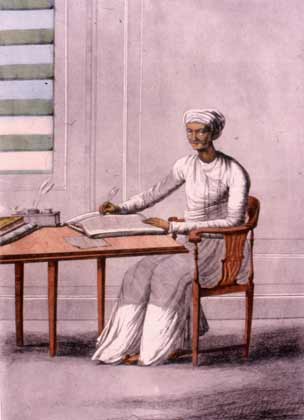
Kshatriya is one of the four varnas of Hindu society and is associated with the warrior aristocracy. The Sanskrit term kṣatriyaḥ is used in the context of later Vedic society wherein members were organised into four classes: brahmin, kshatriya, vaishya, and shudra.
Jāti is the term traditionally used to describe a cohesive group of people in the Indian subcontinent, like a tribe, community, clan, sub-clan, or a religious sect. Each Jāti typically has an association with an occupation, geography or tribe. Different intrareligious beliefs or linguistic groupings may also define some Jātis. The term is often translated approximately in English as caste.
Shudra or Shoodra is the one of the four varnas of the Hindu varna system and social order in ancient India. Some sources translate it into English as a caste, or alternatively as a social class. Theoretically, Shudras constituted a class like employees.

Bihar is a state in eastern India. It is the third largest state by population, the 12th largest by area, and the 14th largest by GDP in 2021. Bihar borders Uttar Pradesh to its west, Nepal to the north, the northern part of West Bengal to the east, and Jharkhand to the south. The Bihar plain is split by the river Ganges, which flows from west to east.
Varṇa, in the context of Hinduism, refers to a social class within a hierarchical traditional Hindu society. The ideology is epitomized in texts like Manusmriti, which describes and ranks four varnas, and prescribes their occupations, requirements and duties, or Dharma.
Untouchability is a form of social institution that legitimises and enforces practices that are discriminatory, humiliating, exclusionary and exploitative against people belonging to certain social groups. Although comparable forms of discrimination are found all over the world, untouchability involving the caste system is largely unique to South Asia.

Robert Caldwell was a missionary for London Missionary Society. He arrived in British India at age 24, and studied the local language to spread the word of the Bible in a vernacular language, studies that led him to author a text on comparative grammar of the South Indian languages. In his book, Caldwell proposed that there are Dravidian words in the Hebrew of the Old Testament, the archaic Greek language, and the places named by Ptolemy.

Kayastha or Kayasth denotes a cluster of disparate Indian communities broadly categorised by the regions of the Indian subcontinent in which they were traditionally located—the Chitraguptavanshi Kayasthas of North India, the Chandraseniya Kayastha Prabhus of Maharashtra, the Bengali Kayasthas of Bengal and Karanas of Odisha. All of them were traditionally considered "writing castes", who had historically served the ruling powers as administrators, ministers and record-keepers.
Sanskritisation is a term in sociology which refers to the process by which castes or tribes placed lower in the caste hierarchy seek 'upward' mobility by emulating the rituals and practices of the dominant castes or upper castes. It is a process similar to "passing" in sociological terms. This term was made popular by Indian sociologist M. N. Srinivas in the 1950s. Sanskritisation has in particular been observed among mid-ranked members of caste-based social hierarchies.

Indian feudalism refers to the feudal society that made up India's social structure until the formation of Republic of India in the 20th century.

The history of Bihar is one of the most varied in India.Chirand, on the northern bank of the Ganga River, in Saran district, has an archaeological record dating from the Neolithic age. Regions of Bihar—such as Magadha, Mithila and Anga—are mentioned in religious texts and epics of ancient India. Mithila is believed to be the centre of Indian power in the Later Vedic period. Mithila first gained prominence after the establishment of the ancient Videha Kingdom. The kings of the Videha were called Janakas. A daughter of one of the Janaks of Mithila, Sita, is mentioned as consort of Lord Rama in the Hindu epic Ramayana. The kingdom later became incorporated into the Vajjika League which had its capital in the city of Vaishali, which is also in Mithila.
Who Were the Shudras? is a history book published by Indian social reformer and polymath B. R. Ambedkar in 1946. The book discusses the origin of the Shudra Varna. Ambedkar dedicated the book to Jyotirao Phule (1827–1890).
Dvija means "twice-born". The concept is premised on the belief that a person is first born physically and at a later date is born for a second time spiritually, usually when he undergoes the rite of passage that initiates him into a school for Vedic studies. The term also refers to members of the three varnas in the traditional Hindu social system, or social classes — the Brahmins, Kshatriyas (warriors), and Vaishyas — whose samskara of the Upanayana initiation was regarded as a second or spiritual birth.

Ram Sharan Sharma was an Indian historian and Indologist who specialised in the history of Ancient and early Medieval India. He taught at Patna University and Delhi University (1973–85) and was visiting faculty at University of Toronto (1965–1966). He also was a senior fellow at the School of Oriental and African Studies, University of London. He was a University Grants Commission National Fellow (1958–81) and the president of Indian History Congress in 1975. It was during his tenure as the dean of Delhi University's History Department that major expansion of the department took place in the 1970s. The creation of most of the positions in the department were the results of his efforts. He was the founding Chairman of the Indian Council of Historical Research (ICHR) and a historian of international repute.

The caste system in India is the paradigmatic ethnographic instance of social classification based on castes. It has its origins in ancient India, and was transformed by various ruling elites in medieval, early-modern, and modern India, especially in the aftermath of the collapse of the Mughal Empire and the establishment of the British Raj. It is today the basis of affirmative action programmes in India as enforced through its constitution. The caste system consists of two different concepts, varna and jati, which may be regarded as different levels of analysis of this system.

Dwijendra Narayan Jha was an Indian historian who studied and wrote on ancient and medieval India. He was a professor of history at Delhi University and a member of the Indian Council of Historical Research. Some of his books include Ancient India: In Historical Outline (1997), The Myth of the Holy Cow (2001), and Early India: A Concise History (2004). Through his works he argued against the communal distortions of history including challenging popular beliefs of the sanctity of cow and Indian beef eating tradition.
Bhumihar, also locally called Bhuinhar and Babhan, is a Hindu caste mainly found in Bihar, the Purvanchal region of Uttar Pradesh, Jharkhand, the Bundelkhand region of Madhya Pradesh, and Nepal.
Baidya or Vaidya is a Hindu community located in Bengal. A caste (jāti) of Ayurvedic physicians, the Baidyas have long had pre-eminence in society alongside Brahmins and Kayasthas. In the colonial era, the Bhadraloks were drawn primarily, but not exclusively, from these three upper castes, who continue to maintain a collective hegemony in West Bengal.

Bengali Kayastha, is a Bengali Hindu caste originated from the Bengal region of Indian subcontinent, and is one of the main subgroups of the Kayastha community. The historical caste occupation of Kayasthas throughout India has been that of scribes, administrators, ministers and record-keepers; the Kayasthas in Bengal, along with Brahmins and Baidyas, are regarded among the three traditional higher castes that comprise the "upper layer of Hindu society." During the British Raj, the Bhadraloks of Bengal were drawn primarily, but not exclusively, from these three castes, who continue to maintain a collective hegemony in West Bengal.
Kundu is a common Bengali Hindu surname found among the Bengali Kayastha, Teli and some other communities of India and Bangladesh.









